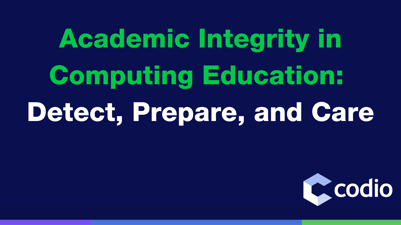Even today, Computer Science Education is a relatively new and rapidly evolving field. To build a responsive product, Codio keeps up with Computing Education Research (CER) and Computer Science teaching practices by regularly reviewing research articles, news, and trends, as well as conducting our own research.
Over the past several months, we surveyed dozens of Higher Ed CS instructors to better understand the state of computer science education in higher education institutions. What we found was intriguing, though not necessarily surprising.
After analyzing the data, we synthesized the findings with recently published community knowledge that we at Codio have been reading into a report to support communication between computing education researchers and practitioners, enabling better CS education for everyone.
Many computing education researchers and projects aim to improve how computing is taught and learned. Denny et al (2019) found that 78% of the 118 surveyed computing educators “would make a direct change to their teaching practice if at least one of their [research] questions was answered” (Denny, 2019, p. 264).
As we have seen in the past year, traditional textbooks are on the decline (Johnson, 2019) and being replaced or supplemented by different OER materials (Seaman, & Seaman, 2017; Pitt, Farrow, Jordan, de los Arcos, Weller, Kernohan, and Rolfe, 2019) and technology platforms (Top Hat, 2018).
Additionally, computer science learners are slowly moving to less traditional spaces (Arbeit, Bentz, Cataldi, and Sanders, 2019)—many of which are online (Online Higher Education. Hyper Fragmentation and the US Post Secondary Market, 2019). These drastic changes, particularly in higher education institutions, are causing an increased need for technology in CS teaching.
As teachers and instructors increasingly adopt these new edTech platforms, it is important to know what features are most valuable and how these tools are being adopted and combined specifically within a CS education context. Additionally, to better understand the motivations behind these shifts, it is worth identifying the pain points that are at the top of mind and possibly not being fully addressed by current tools.
Survey Findings
Participants identified their most significant challenges and needs in terms of feedback and grading, curriculum creation and setup, course administration, and flexible course materials. Respondents ranged from graduate students to department chairs, and they taught classes ranging in size from 7 to 2,000 students, with 16.7% of class rosters reaching into the triple digits.
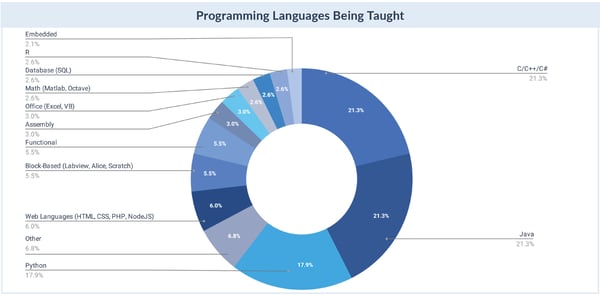
Languages being taught were dominated by the C family (C/C++/C#), Java, and Python. Student enrollment numbers were highest (29.6%) in CS1 with business courses close behind (22.2%)—more than double those of CS2: Data Structures (10.6%).
Course Admin, Grading, and Curriculum Challenges
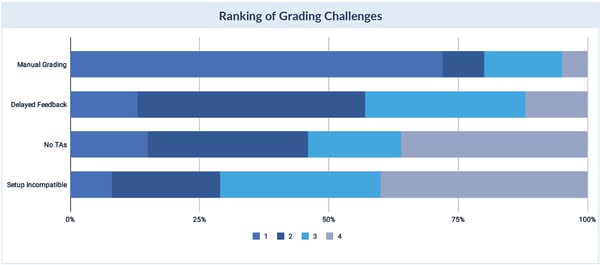 In terms of student feedback, manual grading was the highest priority pain point (72%)—ranked higher by those teaching at a smaller scale due to the lack of TA resources.
In terms of student feedback, manual grading was the highest priority pain point (72%)—ranked higher by those teaching at a smaller scale due to the lack of TA resources.
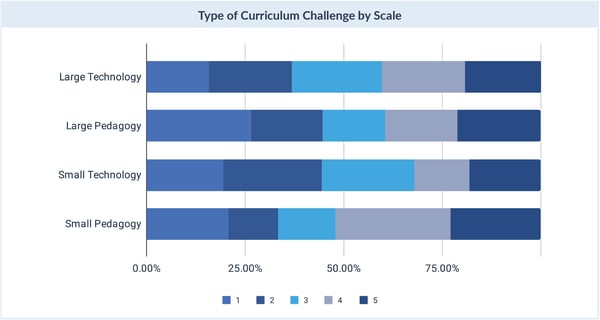 In terms of curriculum, teachers of small classes struggled with technology-related challenges—such as acting as technical support—where large scale courses cited pedagogical concerns such as low student engagement as their top concern. This concern could be a result of resource distribution—similar to the student feedback findings.
In terms of curriculum, teachers of small classes struggled with technology-related challenges—such as acting as technical support—where large scale courses cited pedagogical concerns such as low student engagement as their top concern. This concern could be a result of resource distribution—similar to the student feedback findings.
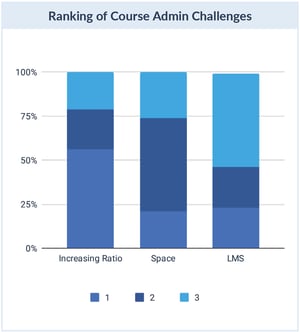 For course admin, the majority of teachers (56%) were primarily concerned with increasing student-to-teacher ratios followed by inappropriate classroom or lab space. Over 75% reported physical lab resources. However, 58% indicated virtual labs, student VMs, and/or cloud resources—a possible indication of a shift towards online learning in higher education. This is complicated by the fact that while 26% of physical lab costs are translated to the students where the resources exist, 40% of instructors do not know who is responsible for paying for virtual lab technology.
For course admin, the majority of teachers (56%) were primarily concerned with increasing student-to-teacher ratios followed by inappropriate classroom or lab space. Over 75% reported physical lab resources. However, 58% indicated virtual labs, student VMs, and/or cloud resources—a possible indication of a shift towards online learning in higher education. This is complicated by the fact that while 26% of physical lab costs are translated to the students where the resources exist, 40% of instructors do not know who is responsible for paying for virtual lab technology.
Teaching Resources: Most Use OERs
"58% of classes have students paying for resources that the teacher then supplements with OERs to meet their needs."
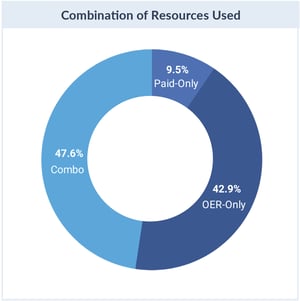 A shockingly large 61.3% reported Open Educational Resource (OER) usage—with only 9.5% of teachings relying on purely paid resources. Small courses were over twice as likely to use paid only than larger courses (13.6% in small to 5.3% in large). Most who used paid resources used them in conjunction with OER—47.6%—whereas 42.9% used only OERs.
A shockingly large 61.3% reported Open Educational Resource (OER) usage—with only 9.5% of teachings relying on purely paid resources. Small courses were over twice as likely to use paid only than larger courses (13.6% in small to 5.3% in large). Most who used paid resources used them in conjunction with OER—47.6%—whereas 42.9% used only OERs.
This is troubling as it might indicate a lack of appropriate paid materials—but students are by-and-large being asked to pay for these inadequate resources. 95% of students are responsible for textbooks, and half of the students using paid platforms are paying out of pocket. 58% of classes have students paying for resources that the teacher then supplements with OERs to meet their needs.
Many instructors were interested in curricular assessment resources, favoring editable, auto-graded questions over questions in text or a simple bank of questions. Similarly, instructors ranked editable text over a simple PDF or digital text. This reiterates educators’ increasing need to customize content for their context.
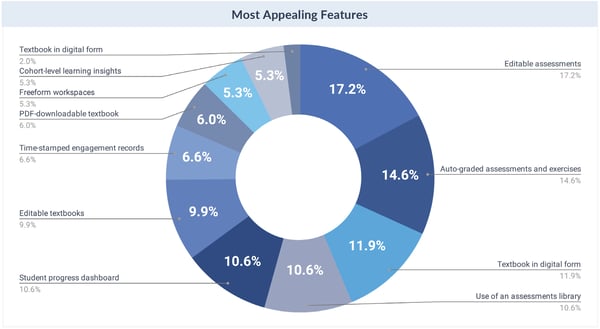
When looking at what would cause a teacher to shift platforms, a downloadable PDF and the student dashboard dropped noticeably. A digital textbook that allowed students to write and run code jumped from 6th to 3rd on teachers’ list of priorities.
Do these findings sound familiar? We'd love to hear your experience. Let us know if you'd like to participate in future surveys.
References
Arbeit, C. A., Bentz, A., Cataldi, E. F., and Sanders, H. (2019). Alternative and Independent: The Universe of Technology-Related “Bootcamps.” RTI Press Publication No. RR-0033-1902. Research Triangle Park, NC: RTI Press. https://doi.org/10.3768/rtipress.2018.rr.0033.1902
Denny, P., Becker, B. A., Craig, M., Wilson, G., & Banaszkiewicz, P. (2019, July). Research This! Questions that Computing Educators Most Want Computing Education Researchers to Answer. In Proceedings of the 2019 ACM Conference on International Computing Education Research (pp. 259-267). ACM.
Johnson, E. (2019, August 2). “The $300 textbook is dead,” says the CEO of textbook maker Pearson. Retrieved from https://www.vox.com/recode/2019/8/2/20750863/john-fallon-pearson-education-textbook-digital-aida-teachers-kara-swisher-recode-decode-podcast
Online Higher Education. Hyper Fragmentation and the US Post Secondary Market. (2019, August 1). Retrieved from https://www.holoniq.com/notes/online-higher-ed.-hyper-fragmentation-and-the-us-post-secondary-market/?mc_cid=9a4eaaa11b&mc_eid=fa821c03c9
Pitt, Rebecca; Farrow, Robert; Jordan, Katy; de los Arcos, Beatriz; Weller, Martin; Kernohan, D and Rolfe, V (2019). The UK Open Textbooks Report. Open Education Research Hub.
Seaman, J. E., & Seaman, J. (2017). Opening the Textbook: Educational Resources in US Higher Education, 2017. Babson Survey Research Group.
Top Hat. (2018). Professor Pulse 2018. Professor Pulse 2018. Retrieved from https://tophat.com/wp-content/uploads/Professor-Pulse-Full-Report-Top-Hat.pdf




